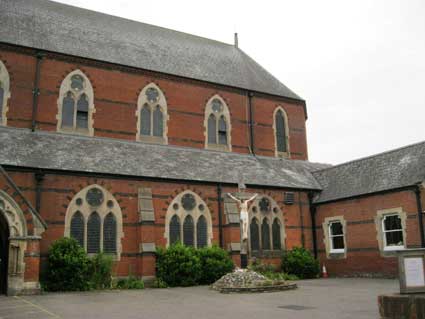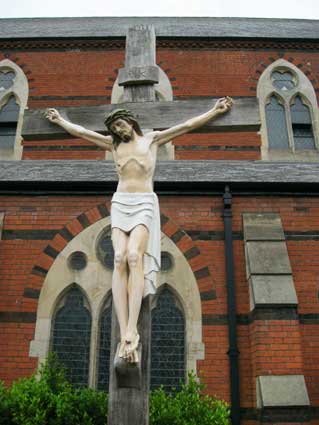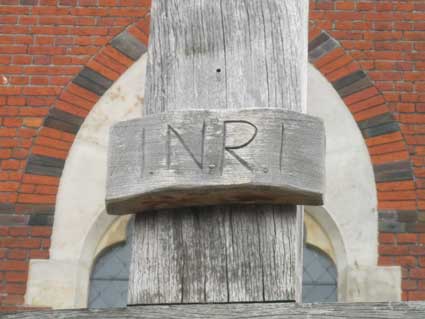St Pancras Church
St Pancras once towered over slum housing in the Cox Lane area
of
the town (now mainly car parks). This building has very little in the
way of public lettering,
but we include it here for the typical, painted wooden crucifixion
figure at the front of the church.

'I.N.R.I.' is carved on the upper scroll. These letters are
initials come from the biblical story and stand for the Latin title
that Pontius Pilate had written over the head of Jesus Christ on the
cross. Latin was the official language of the Roman Empire. The words
were "Iesvs Nazarenvs Rex Ivdaeorvm." Latin uses “I” instead of the
English “J”, and “V” instead of “U”. The English translation is "Jesus
of Nazareth, the King of the Jews."


"Seen from across the car park, the only clue that it was once
tightly surrounded by poor people's houses is that there are no windows
in the wall of the north aisle. St Pancras looks rather like a bit
dropped off. This is because that is exactly what it is. The architect,
George Goldie's, commission was for the huge, recently demolished
School of Jesus and Mary on the campus of the Woodbridge Road church of
St Mary, and this town centre church in the same style. St Pancras was
intended to be the start of a great cathedral, of which the surviving
church was but the chancel. At the time, Ipswich was in the Diocese of
Northampton; today, it is in the Diocese of East Anglia, with a great
stone Gothic cathedral at Norwich. But the Norwich cathedral, built as
the church of St John the Baptist, and the equally grand Our Lady and
the English Martyrs in Cambridge, were both begun a good thirty years
after St Pancras [1861]. If it had ever been finished, St Pancras would
have been one of the biggest red brick churches in England.
The Catholic presence in Ipswich had been re-established in the 1790s,
at the time of the French Revolution, by a refugee Priest, Louis Simon.
He said Mass in the home of a rich local lady Margaret Wood, and then
with her help established a mission church near the Woodbridge Road
barracks. This church, St Anthony, formed the transepts of the building
that still survives as the parish hall of the 1960 St Mary. After the
re-establishment of the Catholic hierarchy in England, the plan was to
create a town centre profile for the Church, and this was why Goldie
was commissioned to build St Pancras. However, anti-Catholic feeling
was rather stronger than it had been seventy years previously. On a
night in November 1862, the protestant ministers of the town whipped up
such a state of hysteria that angry mobs ran through Ipswich smashing
windows of Catholic churches, homes and businesses."
[The above information taken
from Simon's Suffolk Churches, see Links.]
Home
Please email any comments
and contributions by clicking here.
Search Ipswich
Historic Lettering
©2004 Copyright
throughout the Ipswich
Historic Lettering site: Borin Van Loon
No reproduction of text or images without express written permission


